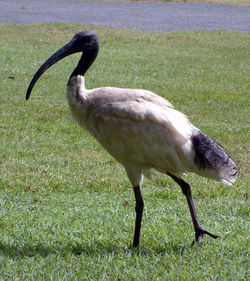|
Threskiornithidae |

Australian White Ibis
|
|
Scientific classification |
| Kingdom: |
Animalia
|
| Phylum: |
Chordata
|
| Class: |
Aves
|
| Order: |
Ciconiiformes
|
| Family: |
Threskiornithidae
Richmond, 1917 |
|
| Subfamilies |
Threskionithinae (ibises)
Plateinae (spoonbills)
|
The
family Threskiornithidae includes 36
species of large terrestrial and wading
birds, falling into two subfamilies, the
ibises and the
spoonbills. It was formerly known as Plataleidae.
The spoonbills and ibises are related to other groups of
long-legged wading birds in the order Ciconiiformes,
including the
storks, the
herons, and the bitterns.
Members of the family have long, broad wings with 11
primary
feathers and about 20 secondaries. They are strong
fliers and, rather surprisingly, given their size and
weight, very capable soarers. The body tends to be
elongated, the neck more so, with rather long legs. The bill
is also long, decurved in the case of the ibises, straight
and distinctively flattened in the spoonbills.
They are distributed almost worldwide, being found near
almost any area of standing or slow-flowing fresh or
brackish water. Ibises are also found in drier areas,
including city rubbish tips. All are diurnal; spending the
day feeding on a wide range of invertebrates and small
vertebrates: ibises by probing in soft earth or mud,
spoonbills by swinging the bill from side to side in shallow
water. At night, they roost in trees near water. They are
gregarious, feeding, roosting, and flying together, often in
formation.
Nesting is colonial in ibises, more often in small groups
or singly in spoonbills, nearly always in trees overhanging
water, but sometimes on islands or small islands in swamps.
Generally, the female builds a large structure out of reeds
and sticks brought by the male. Typical clutch size is 2 to
5; hatching is asynchronic. Both sexes incubate in shifts,
and after hatching feed the young by partial regurgitation.
Two or three weeks after hatching, the young no longer need
to be brooded continuously and may leave the nest, often
forming creches but returning to be fed by the parents.
External links




